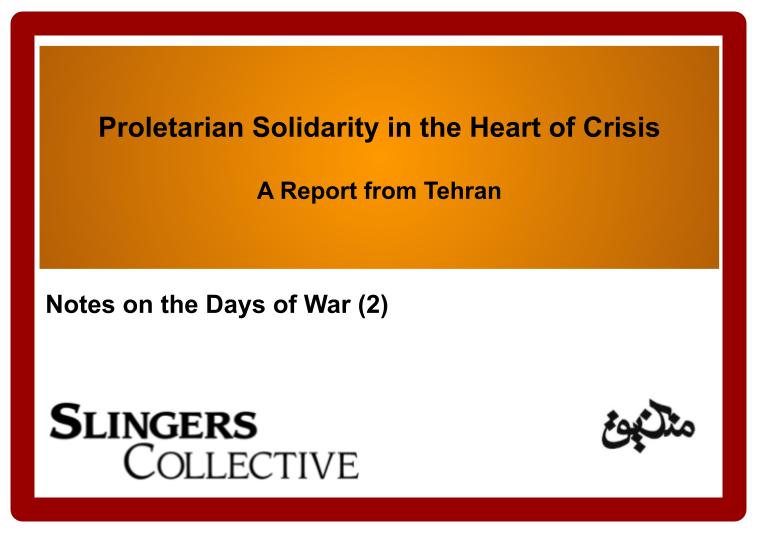The Slingers Collective is the international branch of Manjanigh. Manjanigh is publishing Notes on the Days of War across its various media outlets, including social media platforms. We are translating selected pieces that may be of interest to our non-Farsi-speaking audience.
A Report from Tehran:
Gigantic black and white columns of smoke are visible from various parts of Tehran. Throughout the past nights, terrifying sounds of explosions and air defense systems continued until sunrise. But mornings begin quietly. A black smoke column rising from the Shahr-e Rey refinery still looms high in the sky. The shortage of gasoline and diesel is expected following the targeting of the Tehran refinery, the oil reservoirs in Shahran, and the oil depot. According to official sources, Iran’s strategic gasoline reserves support only three days of the country’s consumption. Apart from the impact of gasoline shortages on scarcity and price hikes of goods, the working class heavily relies fundamentally on gasoline. Partly due to daily commuting from the outskirts to the center, and partly because of the large number of people who make their living on Tehran streets. The city streets are much quieter than ordinary days, but the lines at gas station pumps are still long. Evacuation warnings have terrified people in Tehran. In the metro and on the streets, people with suitcases are noticeable, leaving Tehran. There is a shortage of cars for leaving Tehran. The taxi fares are so absurdly high that they provoke bitter laughter. “Class” reveals itself directly as it emerges through these circumstances. Escaping the bombs of the Zionist occupying regime doesn’t require willpower; it requires money. Workers, wage earners, and employees, even if they want to, cannot distance themselves from daily life and its chains for long.
Special units are present in all main squares and thoroughfares, reminiscent of the time of the Jina uprising, spraying water on their heads and faces due to the intense heat. They are asserting their presence while inspecting covered trucks, vans, and other suspicious items. These inspections are so frequent that some covered trucks have raised their cargo covers. Some have parked alongside the street or left the car at random. Basij and Revolutionary Guard inspection posts are also busy day and night (more intensely at night). Government media have announced not to overwhelm the security forces’ phones and to only call in emergencies. Eyes clearly monitor each other, and the government advances in civil society, from the police who kill the people, to people who police over others. War is a matter of social order, and the government is trying to build a stronghold from civil society, its institutions, and potential forces. At the same time, it tries to strengthen the suppression apparatus by deploying this new energy and making consensus through its ideological apparatus.
Banks have been instructed to keep their shutters half-closed and be prepared for emergency situations (specifically riots or looting). Patrol units and plainclothes agents are roaming the streets on motorcycles and in cars. War is the only topic of conversation among the people. Perhaps during the first and second days of the war, some people were still waiting for the child-killing saviors to finish the job. But Sunday was a different day. Multiple areas in Tehran (Keshavarz Boulevard, Mehrabad, Niavaran, Chitgar, Hakimiyeh, etc.), as well as suburban areas like Eslamshahr, were targeted.
The false, bourgeois dichotomy of “either the Islamic Republic or Israel” is rapidly collapsing, and the first drops of crisis fall on the roof of the working class. Anxiety over hunger, homelessness, and unemployment is sweeping through the ranks of workers. And yet, what is seen in abundance is the resilient and tempered spirit of the proletariat. Is this the first crisis the working class has faced?! This class has lived through various crises for years and has learned to quickly adapt to new forms of hardship. This is even visible in its social behavior: while in the more proletarian neighborhoods of the city, life largely continues only briefly interrupted by the intervals between explosions in the neighborhoods inhabited by the middle class, even the speed of car traffic has multiplied under the impact of the war.
People’s shopping bags are fuller and more plentiful than before, and the lines at bakeries are long. Here too, the atmosphere in downtown and southern Tehran is noticeably different. In the lower parts of the city, shops sell goods in quantities that people actually need. Especially canned food, rice, oil, pasta, and other basic necessities. It is the spontaneity of the working class that reins in the fear of counterrevolution through spontaneous acts of a kind of rationing and equitable distribution of resources, without any orders from above.
It’s strange how many people are looking up at the sky. Rarely have we seen the city from this angle, not eyes looking ahead, but eyes turned skyward. And amidst the smoke trails across the sky and the sounds of explosions, in the most critical days of the war, horizons begin to emerge on the ground: many expressions of solidarity and spontaneity that, while we should not exaggerate their actual capacities with poetic idealism, certainly offer space for imagining their potential.



Comment here